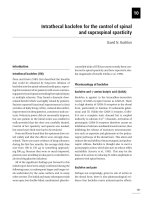Lecture Math for the pharmacy technician: Concepts and calculations: Chapter 8 – Lynn M. Egler, Kathryn A. Booth
Bạn đang xem bản rút gọn của tài liệu. Xem và tải ngay bản đầy đủ của tài liệu tại đây (2.1 MB, 44 trang )
Math for the Pharmacy Technician:
Concepts and Calculations
Egler • Booth
Chapter 8: Intravenous
Calculations
Calculations
McGrawHill
©2010 by the McGrawHill Companies, Inc All Rights Reserved
82
Intravenous Calculations
McGrawHill
©2010 by the McGrawHill Companies, Inc All Rights Reserved
83
Learning Objectives
When you have successfully completed Chapter 8, you will have
mastered skills to be able to:
Identify the components and
concentrations of IV solutions.
Calculate IV flow rates.
Calculate infusion time based on
volume and flow rate.
McGrawHill
©2010 by the McGrawHill Companies, Inc All Rights Reserved
84
Learning Objectives (con’t)
Calculate infusion completion time based
on flow rate.
Calculate volume based on infusion time
and flow rate.
Calculate medications for intermittent IV
infusions.
McGrawHill
©2010 by the McGrawHill Companies, Inc All Rights Reserved
85
Introduction
Intravenous (IV) fluids are solutions
including medication that are delivered
directly into the bloodstream via a vein
Blood is also delivered by IV
IV fluids have a rapid effect
Are necessary during emergencies or
other critical care situations
McGrawHill
©2010 by the McGrawHill Companies, Inc All Rights Reserved
86
IV SolutionsFunctions
Replacement fluids
Maintenance fluids
KVO (Keep Vein Open) fluids
Therapeutic fluids
McGrawHill
©2010 by the McGrawHill Companies, Inc All Rights Reserved
87
IV Replacement Fluids
Replace electrolytes and fluids lost
due to hemorrhage, vomiting, or
diarrhea
Examples:
Whole blood
Nutrient solutions
Fluids to treat dehydration
McGrawHill
©2010 by the McGrawHill Companies, Inc All Rights Reserved
88
IV Maintenance Fluids
Maintain normal electrolyte
and fluid balance
Example:
– Normal
saline given
during and after
surgery
McGrawHill
©2010 by the McGrawHill Companies, Inc All Rights Reserved
89
IV KVO Fluids
To keep the vein open (KVO or TKO)
Example:
5% dextrose in water
McGrawHill
©2010 by the McGrawHill Companies, Inc All Rights Reserved
810
Therapeutic Fluids
•
Deliver medication to
the patient
McGrawHill
©2010 by the McGrawHill Companies, Inc All Rights Reserved
811
IV Labels
Solutions are labeled with
The name of the components
The exact amount of the
components
McGrawHill
©2010 by the McGrawHill Companies, Inc All Rights Reserved
812
IV Labels
IV Labels (con’t)
In abbreviations for IV solutions:
Letters identify the component
Numbers identify the
concentration
McGrawHill
©2010 by the McGrawHill Companies, Inc All Rights Reserved
813
IV Labels
IV Labels (con’t)
Example:
An order for 5% dextrose in Lactated
Ringer’s solution might be
abbreviated in any of the following
ways:
D5LR
D5LR
5% D/LR
D5%LR
McGrawHill
©2010 by the McGrawHill Companies, Inc All Rights Reserved
814
Common Abbreviations
D
W, H20
S
NS, NSS
Dextrose
RL
LR
Ringer’s Lactate
Water
Saline
Normal Saline
(0.9% NaCl)
Lactated Ringer’s
1
2 NS
Half Normal Saline Solution
(0.45% NaCl)
McGrawHill
©2010 by the McGrawHill Companies, Inc All Rights Reserved
815
IV Concentrations
5% Dextrose
It contains 5 g of dextrose per 100 mL.
Normal saline is 0.9% saline
It contains 900 mg, or 0.9 g, of sodium chloride per
100 mL.
½ Normal saline is 0.45% saline
It contains 450 mg, or 0.45 g, of sodium chloride per
100 mL.
McGrawHill
©2010 by the McGrawHill Companies, Inc All Rights Reserved
816
IV Concentrations (con’t)
Isotonic
They have no effect on the fluid balance of the
surrounding cells or tissues.
Examples: D5W, NS, LR
Hypotonic
Fluid moves across the cell membrane into
surrounding cells and tissues.
This movement restores the proper fluid level in cells
and tissues of patients who are dehydrated.
Examples: 0.45% NS, 0.33% NaCI
McGrawHill
©2010 by the McGrawHill Companies, Inc All Rights Reserved
817
IV Concentrations
IV Concentrations (con’t)
Hypertonic
These solutions draw fluids from cells and
tissues across the cell membrane into the
bloodstream.
They are helpful for patients with severe fluid
shifts such as those caused by burns.
Example: 3% saline
McGrawHill
©2010 by the McGrawHill Companies, Inc All Rights Reserved
818
IV Concentrations
IV Concentrations (con’t)
Patients with normal electrolyte levels are
likely to receive isotonic solutions.
Patients with high electrolyte levels will
receive hypotonic solutions.
Patients with low electrolyte levels will
receive hypertonic solutions.
McGrawHill
©2010 by the McGrawHill Companies, Inc All Rights Reserved
819
Compatibility
Additives
Medications, electrolytes, and nutrients
combined with IV solutions
Common additives: potassium chloride,
vitamins B and C, and antibiotics
Come prepackaged in the solution or
may need to be mixed
McGrawHill
©2010 by the McGrawHill Companies, Inc All Rights Reserved
820
Compatibility
Compatibility (con’t)
Before combining any medications,
electrolytes, or nutrients with an IV
solution, be sure the components are
compatible.
McGrawHill
©2010 by the McGrawHill Companies, Inc All Rights Reserved
821
Incompatible Combinations
Examples
Ampicillin + 5% dextrose in water
Cefotaxime sodium + Sodium bicarbonate
Diazepam + Potassium chloride
Dopamine HCl + Sodium bicarbonate
Penicillin
+ Heparin
Penicillin
+ Vitamin B complex
Sodium bicarbonate + Lactated Ringer’s
Tetracycline HCl + Calcium chloride
McGrawHill
©2010 by the McGrawHill Companies, Inc All Rights Reserved
822
Calculating Flow Rates
To calculate flow rates in milliliter per hour,
identify the following:
V (volume) is expressed in milliliters
T (time) must be expressed in hours (convert the units
when necessary using calculation methods)
F (flow rate) will be rounded to the nearest tenth
F
V Use the formula method or dimensional analysis to
determine the flow rate in milliliters per hour.
T
McGrawHill
©2010 by the McGrawHill Companies, Inc All Rights Reserved
823
Review and Practice
Find the flow rate.
• Ordered: 500 mg ampicillin in 100 mL NS to
infuse over 30 minutes
Flow rate = 200 mL/h
McGrawHill
©2010 by the McGrawHill Companies, Inc All Rights Reserved
824
Calculating Flow Rates for
Manual Regulation
To determine the flow rate (f) in drops per
minute:
1.
Change the flow rate mL/h (F) to
gtt(drops)/min (f) using the formula
f
FxC
60
where
F = the flow rate in milliliters/hour
C = the calibration factor of the tubing in drops per mL
60 = number of minutes in an hour
McGrawHill
©2010 by the McGrawHill Companies, Inc All Rights Reserved
825
Review and Practice
• Find the flow rate in drops per minute that is
equal to 35 mL/hour using 60 gtt (Drops) /mL
microdrop tubing.
Flow rate = 35 gtt/min
McGrawHill
©2010 by the McGrawHill Companies, Inc All Rights Reserved









